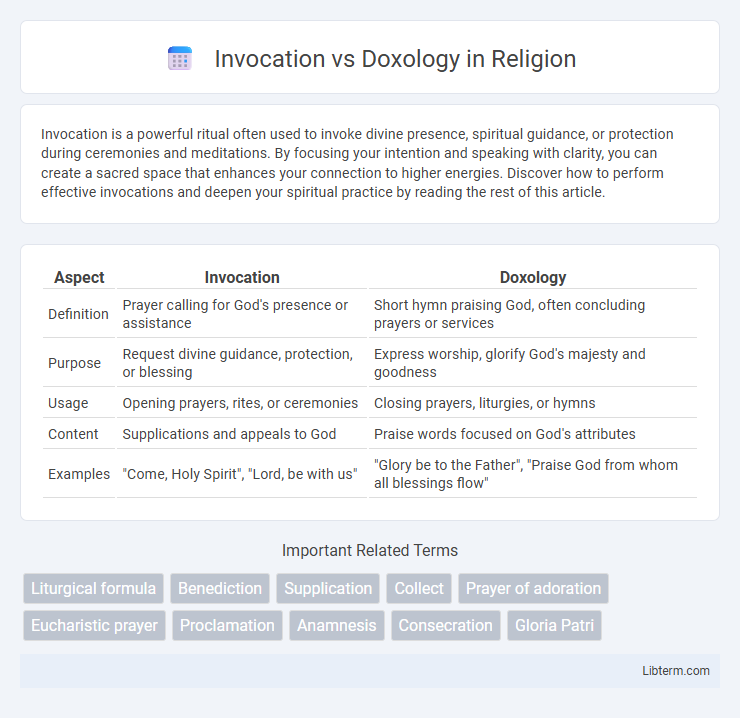Invocation is a powerful ritual often used to invoke divine presence, spiritual guidance, or protection during ceremonies and meditations. By focusing your intention and speaking with clarity, you can create a sacred space that enhances your connection to higher energies. Discover how to perform effective invocations and deepen your spiritual practice by reading the rest of this article.
Table of Comparison
| Aspect | Invocation | Doxology |
|---|---|---|
| Definition | Prayer calling for God's presence or assistance | Short hymn praising God, often concluding prayers or services |
| Purpose | Request divine guidance, protection, or blessing | Express worship, glorify God's majesty and goodness |
| Usage | Opening prayers, rites, or ceremonies | Closing prayers, liturgies, or hymns |
| Content | Supplications and appeals to God | Praise words focused on God's attributes |
| Examples | "Come, Holy Spirit", "Lord, be with us" | "Glory be to the Father", "Praise God from whom all blessings flow" |
Understanding Invocation: Definition and Purpose
Invocation is a solemn prayer or request calling upon a higher power for guidance, blessing, or presence at the beginning of a ceremony or gathering, serving to set a reverent tone. It functions as a spiritual opening that seeks divine assistance and aligns the participants' intentions with a sacred purpose. This practice emphasizes connection with the divine and establishes the framework for worship or reflection.
What is Doxology? Meaning and Significance
Doxology is a short hymn of praise to God, commonly used in Christian worship to express gratitude and reverence. It typically concludes prayers or liturgical services, emphasizing the glory and majesty of the Divine Trinity--Father, Son, and Holy Spirit. The significance of doxology lies in its role as a unifying and affirming declaration of faith, reinforcing communal worship and theological beliefs.
Historical Origins of Invocation and Doxology
Invocation and doxology have distinct historical origins rooted in ancient religious practices. Invocation traces back to early ritual traditions where prayers or chants were directed toward deities to invoke their presence or assistance, commonly found in ancient Mesopotamian, Greek, and Roman ceremonies. Doxology originated in early Christian liturgy as a short hymn of praise to the Trinity, evolving from Jewish praise traditions and becoming a formalized element in worship services by the 4th century CE.
Biblical Foundations for Invocation and Doxology
Invocation in biblical worship is rooted in scripture such as Psalm 103:1-2 and 2 Timothy 1:2, where calling upon God's presence and blessing is emphasized for guidance and sanctification. Doxology, exemplified by passages like Romans 11:36 and Revelation 5:13, serves as a form of praise declaring God's eternal glory and sovereignty. Both practices underscore the theological foundation of honoring God--invocation as an appeal for divine interaction and doxology as an expression of worshipful acknowledgment of His majesty.
Liturgical Roles: When to Use Invocation vs Doxology
Invocation is typically employed at the beginning of a worship service or prayer to call upon the presence and guidance of a divine entity, setting a tone of reverence and focus. Doxology is used at the conclusion of prayers, hymns, or liturgical sections to offer praise and glorification to God, expressing communal worship and thanksgiving. Understanding the liturgical context determines the appropriate use: Invocation initiates dialogue with the divine, while Doxology concludes with exaltation and affirmation of faith.
Key Differences Between Invocation and Doxology
Invocation refers to a prayer or plea asking for divine presence, guidance, or assistance, typically at the beginning of a service or event, while doxology is a short hymn or expression of praise to God, often concluding worship. The key difference lies in their purpose: invocation seeks help or blessing, whereas doxology offers glorification and thanksgiving. Invocation emphasizes supplication and dependence on God, whereas doxology emphasizes adoration and recognition of God's majesty.
Invocation in Modern Worship Services
Invocation in modern worship services functions as a solemn call for God's presence and blessing, setting a reverent tone for the gathering. It often involves specific prayers or scripture readings that invite divine guidance and favor throughout the worship experience. This practice emphasizes communal focus and spiritual preparation, distinguishing it from doxology, which is a short hymn of praise typically sung later in the service.
The Power of Doxology in Christian Praise
Doxology in Christian praise serves as a powerful expression of worship, encapsulating adoration, thanksgiving, and reverence toward God in concise, poetic form. Unlike invocation, which calls upon God's presence or assistance, doxology magnifies God's attributes and eternal nature, reinforcing faith through declarative praise. This form of worship fosters spiritual unity and reinforces doctrinal truths, profoundly impacting both individual believers and congregational worship settings.
Examples of Invocation and Doxology in Practice
Invocation examples often include prayers that call upon divine presence or guidance, such as the opening of a worship service with phrases like "Come, Holy Spirit, fill this place." In contrast, doxology examples typically consist of expressions of praise and worship, exemplified by the hymn "Praise God, from whom all blessings flow." Both serve distinct functions in religious traditions: invocation initiates a spiritual connection, while doxology concludes with glorification.
Choosing the Right Practice: Invocation or Doxology?
Choosing between invocation and doxology depends on the intent and timing within a service or gathering. Invocation serves as a solemn appeal for divine presence and guidance at the beginning of worship, while doxology offers a concluding expression of praise and gratitude to God. Understanding the distinct purposes helps leaders select the appropriate practice to foster reverence, alignment, and worshipful atmosphere.
Invocation Infographic

 libterm.com
libterm.com